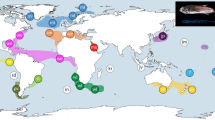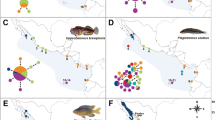Abstract
The northeastern Atlantic and the Mediterranean Sea share geological histories and display great faunal affinities. The majority of the Mediterranean species have Atlantic origins, with a few species with tropical affinities. These include the parrotfish Sparisoma cretense and the wrasse Thalassoma pavo that are restricted to the subtropical northeastern Atlantic, the Macaronesian archipelagos (Azores, Madeira, and Canaries) and the southern Mediterranean. The Pleistocene glaciations have been described as having different effects on the fauna of the two regions. During glacial peaks, Mediterranean waters remained warmer than those of the adjacent Atlantic. Within the eastern Atlantic, the effects of Pleistocene glaciations were differentiated. Here, we perform a comparative analysis focusing on T. pavo and S. cretense populations from the northeastern Atlantic and the Mediterranean to assess the effects of Pleistocene glaciations in these two species. Sequences from the mitochondrial control region were obtained and analyzed combining phylogeographic and demographic approaches. Gene flow between Atlantic and Mediterranean populations was shown to be very high. The Mediterranean populations of T. pavo and S. cretense showed high levels of genetic diversity, even in the eastern basin, pointing to an ancient colonization event. This suggests that both species must have been able to persist in the Mediterranean during the cold Pleistocene periods. Historical migration estimates revealed a Mediterranean towards Atlantic trend in the case of T. pavo, which may reflect the re-colonization of areas in the Atlantic by fish that survived the cold phases in relatively warmer Mediterranean refugia. Our data also showed that within the Macaronesian Archipelagos, migrations occurred from Madeira towards the Azores, for both T. pavo and S. cretense, thus supporting a post-glacial colonization of the Azores by fish that persisted in the warmer region of Madeira. Similar geographic distributions, thermal affinities, and means of dispersion for T. pavo and S. cretense resulted in a similar response to the effects of Pleistocene glaciations, as evidenced by identical phylogeographic patterns.



Similar content being viewed by others
References
Adams J, Maslin M, Thomas E (1999) Sudden climate transitions during the Quaternary. Prog Phys Geogr 23(1):1–36
Almada VC, Oliveira RF, Gonçalves EJ, Almeida AJ, Santos RS, Wirtz P (2001) Patterns of diversity of the north-eastern Atlantic blennid fish fauna (Pisces:Blenniidae). Glob Ecol Biogeogr 10:411–422
Aurelle D, Guillemaud T, Afonso P, Morato T, Wirtz P, Santos RS, Cancela ML (2003) Genetic study of Coris julis (Osteichtyes, Perciformes, Labridae) evolutionary history and dispersal abilities. C R Biol 326:771–785
Ávila SP (2000) Shallow-water marine mollusc of the Azores: biogeographical relationships. Arquipélago Life Mar Sci Suppl 2:99–131
Bargelloni L, Alarcorn JA, Alvarez MC, Penzo E, Magoulas A, Reis C, Patarnello T (2003) Discord in the family Sparidae (Teleostei): divergent phylogeographical patterns across the Atlantic-Mediterranean divide. J Evol Biol 16:1149–1158
Beerli P (2004) migrate: documentation and program, part of lamark. Version 2.0. http://evolution.gs.washington.edu/lamarc.html
Beerli P, Felsenstein J (2001) Maximum likelihood estimation of a migration matrix and effective population sizes in n subpopulations by using a coalescent approach. Proc Natl Acad Sci USA 98:4563–4568
Briggs JC (1996) Global biogeography vol. 14. Developments in paleontology and stratigraphy. Elsevier, Amsterdam
Costagliola D, Robertson DR, Guidetti P, Stefanni S, Wirtz P, Heiser JB, Bernardi G (2004) Evolution of coral reef fish Thalassoma pavo spp. (Labridae). 2. Evolution of the eastern Atlantic species. Mar Biol 144:377–383
Crowley TJ (1981) Temperature and circulation changes in the eastern north Atlantic during the last 150000 years: evidence from the planktonic foraminiferal record. Mar Micropaleontol 6:97–129
De Wolf H, Verhagen R, Backeljau T (2000) Large scale population structure and gene flow in the planktonic developing periwinkle, Littorina striata, in Macaronesia (Mollusca: Gastropoda). J Exp Mar Biol Ecol 246:69–83
Dias JA, Rodrigues A, Magalhães F (1997) Evolução da linha de costa em Portugal, desde o último máximo glaciário até à actualidade: síntese dos conhecimentos. Estudos do Quaternário 1:53–66
Domingues VS, Bucciarelli G, Almada VC, Bernardi G (2005) Historical colonization and demography of the Mediterranean damselfish, Chromis chromis. Mol Ecol 14:4051–4063
Domingues VS, Almada VC, Santos RS, Brito A, Bernardi G (2007) Phylogeography and evolution of the triplefin Tripterygion delaisi (Pisces, Blennioidei). Mar Biol 150:509–519
Domingues VS, Santos RS, Brito A, Almada VC (2006) Historical population dynamics and demography of the eastern Atlantic pomacentrid Chromis limbata (Valenciennes, 1833). Mol Phylogenet Evol 40:139–147
Duggen S, Hoernie K, vanden Bogaard P, Rupke L, Morgan JP (2003) Deep roots of the Messinian salinity crisis. Nature 422:602–606
Dulcic J (2004) Record of ornate wrasse Thalassoma pavo (Labridae) in the Northern Adriatic Sea. Cybium 28:75–76
Duran S, Pascual M, Turon X (2004) Low levels of genetic variation in mtDNA sequences over the western Mediterranean and Atlantic range of the sponge Crambe crambe (Poecilosclerida). Mar Biol 144:31–35
Excoffier L, Smouse PE, Quattro JM (1997) Analysis of molecular variance inferred from metric distances among DNA haplotypes: application to human mitochondrial DNA restriction data. Genetics 131:479–491
Felsenstein J (1985) Confidence limits on phylogenies: an approach using the bootstrap. Evolution 39:783–791
Francour P, Boudouresque CF, Harmelin JG, Harmelin-Vivien ML, Quignard JP (1994) Are the Mediterranean waters becoming warmer? Information from biological indicators. Mar Pollut Bull 28:523–526
González JA (1993) Sparisoma (Euscarus) cretense (L.) (Pisces, Scaridae): Zoogeografía y ciclo reproductor en las Islas Canarias. Courier Forsch.-Inst Senckenberg 159:429–435
Guidetti P, Bianchi CN, La Mesa G, Modena M, Morri C, Sara G, Vacchi M (2002) Abundance and size structure of Thalassoma pavo (Pisces: Labridae) in the western Mediterranean Sea: variability at different spatial scales. J Mar Biol Assoc UK 82:495–500
Hsü KJ, Montadert L, Bernoulli D, Cita MB, Erickson A, Garrison RE, Kidd RB, Mèlierés F, Müller C, Wright R (1977) History of the Mediterranean salinity crisis. Nature 267:399–403
Kitchingman A, Lai S (2004) Inferences on potential seamount locations from mid-resolution bathymetric data. In: Morato T, Pauly D (eds) Seamounts: biodiversity and fisheries, Fisheries Centre Research Report 12 (5), pp 7–12
Kitchingman A, Lai S, Morato T, Pauly D (2007) How many seamounts are there and where are they located? In: Pitcher TJ, Morato T, Hart PJB, Clark MR, Haggan N, Santos RS (eds) Seamounts: ecology, conservation and management. Fish and aquatic resources series. Blackwell, Oxford
Krijgsman W, Hilgen FJ, Raffi I, Sierros FJ, Wilson DS (1999) Chronology, causes and progression of the Messinian salinity crisis. Nature 400:652–655
Lambeck K, Esat TM, Potter E-K (2002) Links between climate and sea levels for the past three million years. Nature 419:199–206
Lee WJ, Conroy J, Howell WH, Kocher TD (1995) Structure and evolution of teleost mitochondrial control regions. J Mol Evol 41:54–66
Malanotte-Rizzoli P, Bergamasco A (1989) The circulation of the eastern Mediterranean. Part I. Oceanol Acta 12:335–351
Nikula R, Väinölä R (2003) Phylogeography of Cerastoderma glaucum (Bivalvia: Cardiidae) across Europe: a major break in the Eastern Mediterranean. Mar Biol 143:339–350
Pannacciulli FG, Bishop JDD, Hawkins SJ (1997) Genetic structure of populations of two species of Chthamalus (Crustacea: Cirripedia) in the north-east Atlantic and Mediterranean. Mar Biol 128:73–82
Patarnello T, Volckaert AMJ, Castilho R (2007) Pillars of Hercules: is the Atlantic-Mediterranean transition a phylogeographic break? Mol Ecol 16:4426–4444
Pérez-Losada M, Guerra A, Sanjuan A (1999) Allozyme differentiation in the cuttlefish Sepia officinalis (Mollusca: Cephalopoda) from the NE Atlantic and Mediterranean. Heredity 83:280–289
Posada D, Crandall KA (1998) Modeltest: testing the model of DNA substitution. Bioinformatics 14:817–818
Quignard J-P, Pras A (1986a) Labridae. In: Whitehead PJP, Bauchot M-L, Hureau J-C, Nielsen J, Tortonese E (eds) Fishes of the north-eastern Atlantic and the Mediterranean. UNESCO, Paris, pp 919–942
Quignard J-P, Pras A (1986b) Scaridae. In: Whitehead PJP, Bauchot M-L, Hureau J-C, Nielsen J, Tortonese E (eds) Fishes of the North-Eastern Atlantic and the Mediterranean. UNESCO, Paris, pp 943–944
Raventós N, Macpherson E (2001) Planktonic larval duration and settlement marks on the otoliths of Mediterranean littoral fishes. Mar Biol 138:1115–1120
Riginos C, Victor BC (2001) Larval spatial distributions and other early life-history characteristics predict genetic differentiation in eastern Pacific blennioid fishes. Proc R Soc Lond B 268:1931–1936
Robertson DR, Karg F, de Moura RL, Victor BC, Bernardi G (2006) Mechanisms of speciation and faunal enrichment in Atlantic parrotfishes. Mol Phylogenet Evol 40:795–807
Rozas J, Sánchez-Del Barrio JC, Messeguer X, Rozas R (2003) DnaSP, DNA polymorphism analyses by the coalescent and other methods. Bioinformatics 19:2496–2497
Sara G, Bianchi CN, Morri C (2005) Mating behaviour of the newly-established ornate wrasse Thalassoma pavo (Osteichthyes: Labridae) in the Ligurian Sea (north-western Mediterranean). J Mar Biol Ass UK 85:191–196
Sambrook J, Fritsch EF, Maniatis T (1989) Molecular cloning a laboratory manual, 2nd edn. Cold Spring Harbor Laboratory Press, New York
Santos RS, Hawkins S, Monteiro LR, Alves M, Isidro EJ (1995) Marine research, resources and conservation in the Azores. Aquat Conserv Mar Freshw Ecosyst 5:311–354
Schneider S, Roessli D, Excoffier L (2000) ARLEQUIN, Version 2.000: a software for population genetics data analysis. University of Geneva, Switzerland
Shulman MJ, Bermingham E (1995) Early life histories, ocean currents, and the population genetics of Caribbean reef fishes. Evolution 49:897–910
Sorenson MD, Ast JC, Dimcheff DE, Yuri T, Mindell DP (1999) Primers for a PCR-based approach to mitochondrial genome sequencing in birds and other vertebrates. Mol Phyl Evol 12(2):105–114
Swofford DL (1998) PAUP: phylogenetic analysis using parsimony and other methods. Sinauer Associates, Sunderland, MA
Thiede J (1978) A glacial Mediterranean. Nature 276:680–683
Acknowledgments
We are grateful to R. Araújo from Estação Marítima do Funchal for providing samples from Madeira. We thank M. Ramon for help in the lab and N. Serpa for sampling in the Azores. Vera S. Domingues has a doctoral fellowship from the Portuguese Foundation for Science and Technology (FCT) (SFRH/BD/13069/2003). Research at ISPA-UIE (UI&D #331/94) and IMAR-DOP/UAz (UI&D #531 and LA#9) are funded by FCT through pluri-annual and programmatic funding schemes (FEDER). IMAR-DOP/UAz research is also granted by DRCT. This paper is also a contribution to MarBEF (Network of Excellence: “Marine Biodiversity and Ecosystem Functioning”—contract number GOCE-CT-2003–505446).
Author information
Authors and Affiliations
Corresponding author
Additional information
Communicated by J.-M. Gili.
Rights and permissions
About this article
Cite this article
Domingues, V.S., Alexandrou, M., Almada, V.C. et al. Tropical fishes in a temperate sea: evolution of the wrasse Thalassoma pavo and the parrotfish Sparisoma cretense in the Mediterranean and the adjacent Macaronesian and Cape Verde Archipelagos. Mar Biol 154, 465–474 (2008). https://doi.org/10.1007/s00227-008-0941-z
Received:
Accepted:
Published:
Issue Date:
DOI: https://doi.org/10.1007/s00227-008-0941-z




